It’s time to talk about the Nevermind generation – specifically, how to get your CBD products on their radars. One of the first things we noticed when we started following hashtags on social media is that there is a SERIOUS disconnect between the insights brands MUST have about their buyers and the way they use that info to reach them on social media.
I know. I know. Social is time-consuming as hell when you’ve got other things to do. On its own, social media is glorious, but the moment you stick it on a To-Do list, it gets super-hard to understand, all of a sudden.
In this fourth installment of our CBD series, let’s get into the strategies that appeal to the buyer persona High Yield Insights named the Dosing Dad.
Let’s do it.
Who Is Generation X?
Born between 1965 and 1980, Generation X is thought to some of as the “middle child generation. They are often overlooked for the cooler, trendier Millennial market and the won’t overtake Boomers by number for another ten years, according to Pew Research. But Gen Xers wield a significant amount of influence in the market, with spending power that tops $2.4 trillion.
Despite being the hardest hit by the Great Recession, most Gen Xers count the cost of home ownership among their many financial responsibilities… in addition to college tuition, business costs (they’re the entrepreneurial generation who invented hustling), and saving for retirement.
This may explain why Gen Xers are so likely to zero in on good deals and thrifty spending… despite their ample incomes. That said, it’s pretty safe to assume that Generation X will respond positively to the use of compelling UGC in your digital marketing campaigns. They put a lot of stock into researching brands to figure out which companies are worth patronizing.
FINANCIAL POWERHOUSES WITH FINANCIAL RESPONSIBILITIES
According to a recent study released by Merrill Lynch, there is actually what is referred to as an “economy of support”. Millennials and adult Gen Zers are relying on their Gen X and Boomer parents to help them meet financial obligations, to the tune of $500 million a year. The money Gen Xers and Boomers would otherwise earmark for personal purchases and retirement is being reallocated to financially support adult children.
Gen Xers make up around 20 percent of the population, and control 14 percent of the nation’s wealth. But 75 percent of them also help their parents financially, and 52 percent support their adult Millennial children struggling to make it on their own. Add to that the 54 percent of Gen Xers still controlling the spending of younger Gen Z children who are now teens and in their early 20s – entering high school, college and the workforce – and you can see why Gen Xers are smart about their spending.
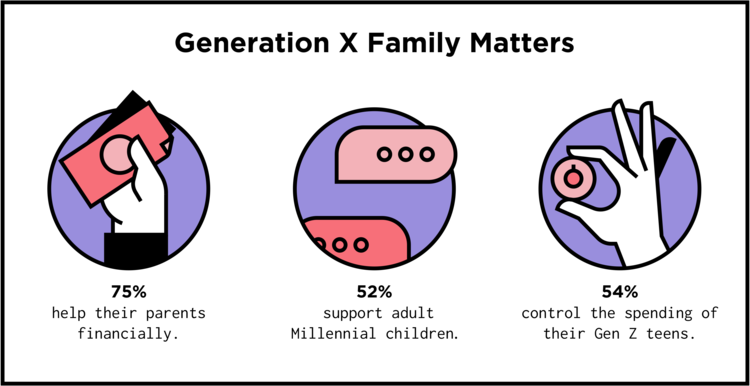
GEN X DOES SOCIAL A LITTLE DIFFERENTLY (OF COURSE THEY DO)
Getting CBD products in front of Gen Xers is a bit different than it would be for reaching Millennials, and even Boomers. Whereas Millennials rely on Instagram and Facebook to discover new products, Gen Xers are not about that ad-in-the-feed life. They use social media to stay connected to friends and family. According to eMarketer, 56 percent of Gen Xers say there is just too much advertising happening on social media.
Makes sense, right? Gen Xers tend to be the independent, go-against-the-grain type. Nearly one in five Gen Xers won’t even share personal info online at all, let alone let you tell them what they like. So, the bad news is you’re probably staring down the barrel of the old “Don’t call me. I’ll call you” vibe.
The good news is we’re gonna tell you how to get past it.
The Two Influencer Marketing Strategies That Will Help You Draw Gen Xers to Your CBD Products
Meet Dosing Dad. He’s a little younger than Senior Susan, the buyer persona we featured in the most recent post in our CBD series. This predominantly male demographic is also just about at their peak earning potential.
With minor children still in the house and many Dosing Dads contributing financially to both their young adult children AND their Boomer parents, the higher income often comes with financial strings already attached. But don’t fret.
That higher income also means CBD brands have the opportunity to introduce Dosing Dads to both high-quality (and even luxury) CBD products and things like pet CBD products (their spouses and partners would probably be thrilled to get in on that action).
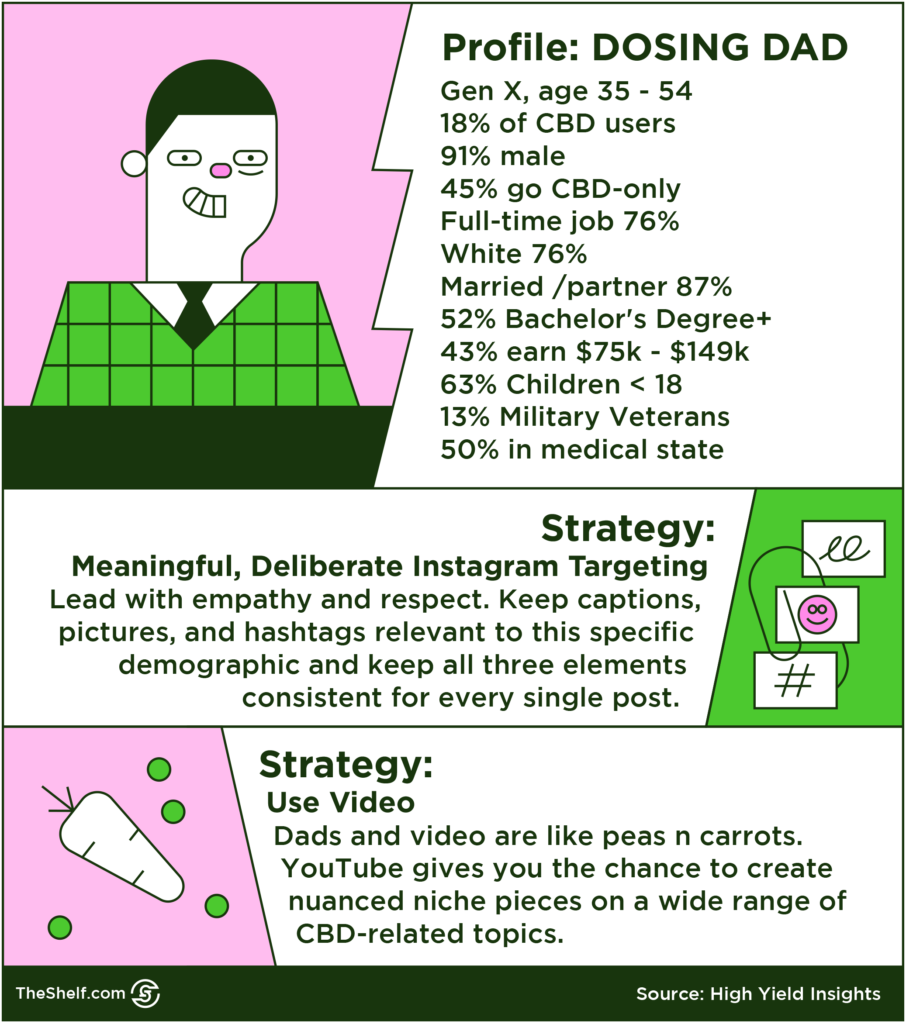
COPY AND PASTE THIS 👇 CODE TO EMBED THIS ☝️GRAPHIC.
Strategy #1: Target Gen Xers Separately, Meaningfully, and Deliberately
There are two things to keep in mind when marketing Dosing Dads (and Dosing Moms). If you notice, 13 percent of this particular demographic is made up of military veterans. So, proceed with respect and empathy. The other thing to remember is that Dosing Dads are usually administering CBD products for a specific purpose that may go beyond being trendy and healthy.
So, lead with plenty of useful information, insights and assistance without being the guy who’s trying to leverage someone else’s experiences (good and bad) to make a buck.
@NEUROXPF
A popular CBD-related hashtag being used on Instagram is #cbdforptsd. I used that tag to find @neuroxpf. What this account does really well is rally CBD supporters together through cannabis education posts and user-generated content from high-profile users that this demographic would recognize and respect (like retired NFL offensive lineman Kyle Turley, who’s everywhere talking about CBD).
The post below isn’t about taking CBD. Instead, it talks about regulations that keep veterans in the cannabis industry from getting home loans.
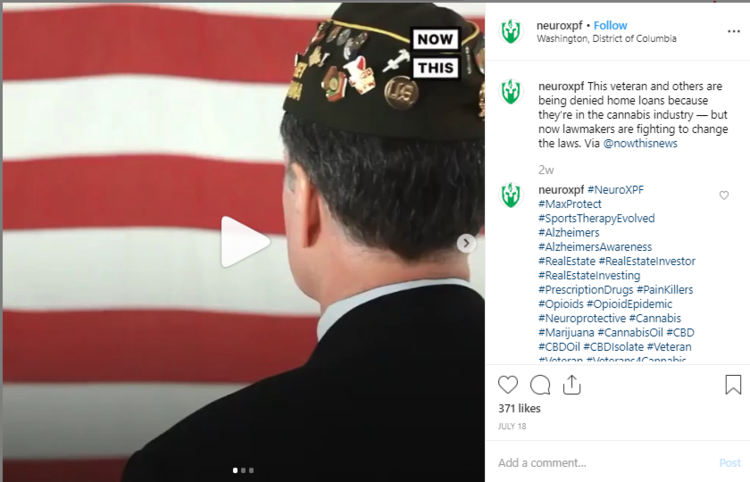
Uh… super random, Sorilbran.
Not really. This post is successfully targeting a demographic that:
- Values home ownership
- Made entrepreneurship cool (twenty years ago, calling yourself an entrepreneur was like being a snake oil salesman, a bad one at that)
- Is accustomed to having to outsmart “the man” and out-hustle the next guy to even earn their keep.
While it may be tempting to overlook this generation, or worse, to lump them in with your millennial targeting, that doesn’t work. Yes, Gen X rode the wave into the Digital Age, and they have become really proficient at living both analog and digital lives simultaneously. But they are not their all-things-social kids, and they are not they’re Kumbaya-singing parents. They are the nut-packed nougat holding those two generations together.
For Gen Xers (who are kinda used to being ignored and overlooked) CONSISTENCY IN YOUR TARGETING will be crucial. Target them deliberately with content that anyone can see is totally aimed at them. That means the images, the hashtags, the captions should all be curated, crafted and aligned to appeal to Gen Xers.
****
I talked extensively about this concept of becoming the resource in the post on grabbing the Baby Boomer CBD Market, too. A good read if you want to use that strategy and it works really well on Facebook (Facebook groups about CBD are gaining traction), too.
****
TILLMAN’S TRANQUILS
Now, take a look at another post I found under the hashtag #cbdforptsd.
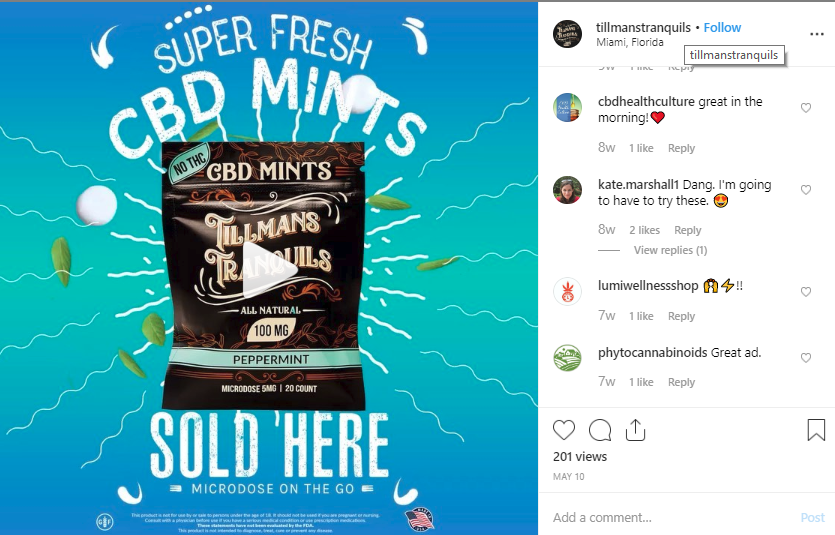
Initially, I thought, “Oh, cool. Microdose on the go…” It’s such an eye-catching post, I wondered why this particular post didn’t get more engagement… that is, until I clicked on the Instagram account associated with this post… and realized the company’s actually targeting a much younger demographic. My knee-jerk response was as a person, not a marketer, and it was that they don’t know a damned thing about PTSD!
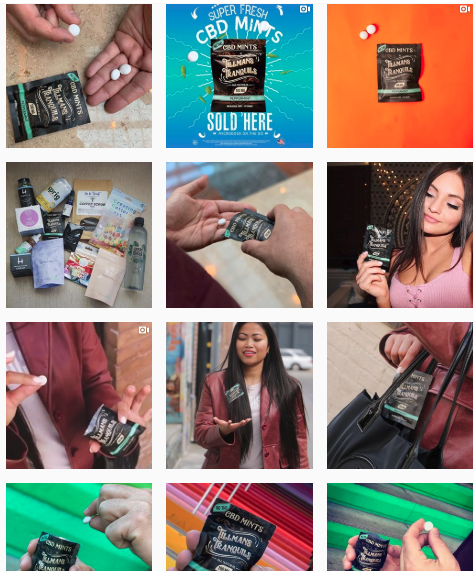
Two things: Not sure why I was so outraged; I don’t have PTSD. AND I honestly have no idea how much Tillman’s Tranquils know about PTSD.
What I do know is that the demographic featured in this feed isn’t consistent with some of the key hashtags they’re using to promote their CBD brand. In fact, none of these pics align with hashtags like #cbdcures #cbdheals #cbdforptsd #cbdforpain.
Remember, I found Tillman’s Tranquils under the hashtag #cbdforptsd. So, there’s a glaring disconnect between their hashtag strategy and the images they post. Which means…Tillman’s has inadvertently given itself a credibility issue. Hashtagging is a way for users to find posts about a certain topic. It’s also a good way for algorithms to identify spam. So, be careful about copy/pasting entire hashtag blocks to “cover all your bases”. Using popular hashtags to draw eyes to an unrelated post is click-baity at best. At worst, you could be creating credibility issues for your brand
Compared to @neuroxpf (who was able to generate 75 percent engagement on Instagram with a single video), 200 views is noticeably low. This instance may just be a case of copied hashtags, but it’s messing with their brand. I’m thinking if they tighten up their targeting, Tillman’s can start kicking some butt. (The Shelf platform can help you nail your targeting. See it in action).
Strategy #2: Video Is a Gen X Dad’s Best Friend
Gen X may be the most adaptable generation yet. When older Gen Xers were the youngest people in the world, having a TV in the home was juuuuust becoming the norm. Now, programmed TV is becoming obsolete as people now spend more time consuming content online than watching live TV. (TV manufacturers were smart to make televisions essentially 50-inch computer screens for watching YouTube and Netflix – that definitely kept electronics companies in the game.)
YOUTUBE IS VITAL
Gen Xers are no exception. They spend A LOT of time watching video, and they account for over 1.5 billion views on YouTube every day. So, there’s a reason YouTube is such an important content delivery method for CBD brands.
Gen Xers aren’t just spending time on YouTube though. While it is an important platform, Gen Xers share content – especially video – more readily to Facebook than any other site. This is closely followed by YouTube and Twitter, showing that in order to reach this generation (well, any generation really), an omnichannel approach is the best strategy.
Why not just stick with Instagram? Well, a couple of reasons. While men under the age of 24 dominate the platform, men over 35 aren’t as enthusiastic. For the older men who are, we’ve discovered they’re not schooled in (or pressed about) the fine art of hashtagging.
So, even for posts from Dosing Dads that probably would be valuable to other Dosing Dads there’s a good chance they will never be found because it’s not uncommon for older men to skip the hashtags (and subsequently skip searching and following hashtags).
The INSANE Edge CBD Brands Get by Creating Content for YouTube
Regardless of age, YouTube is everybody’s favorite place to go to learn new things and to get answers on how to do stuff. CBD is no different. YouTube is a great place to find and create content that addresses very specific health conditions and uses of CBD.
And if Dosing Dad isn’t into Dr. Oz (not a lot of older men really are), he could probably stand a guy’s guy like Joe Rogan, who’s not Thomas-DeLauer-young, but he’s recognized by lots of different people because he was a comedian and a fighter before becoming a podcaster. He was also the host of the show Fear Factor back in the day. In 2001, Fear Factor was the number one show for 18 to 49 year-olds. Coincidentally (or not), Joe is literally the 17th most searched thing on YouTube. Love that guy.
Joe’s on-air personality is of someone who’s insightful, funny, clever and a straight-shooter. He has strong opinions about most things and talks A LOT about vitality. And he’s had his fair share of posts about CBD.
Now, I’m not saying you should try to get Joe Rogan to endorse your product. I mean… good luck with that. But I am trying to drive home the point of why YouTube is a great marketing tool and I’m using Joe as an example because for all his popularity, he’s still pretty niche.
Unlike a Google search, YouTube’s algorithm isn’t as focused on search intent. A broad search term like “CBD Oil” will deliver relevant content from channels I like PLUS those the algorithm calculates I might like. But that first list of search results is sort of a, “tell me more” type of thing.
So, for me, a single search of the term “CBD oil” brought up everything from industry news to religion to government security clearances for people who use CBD oil. These are all first-page results.
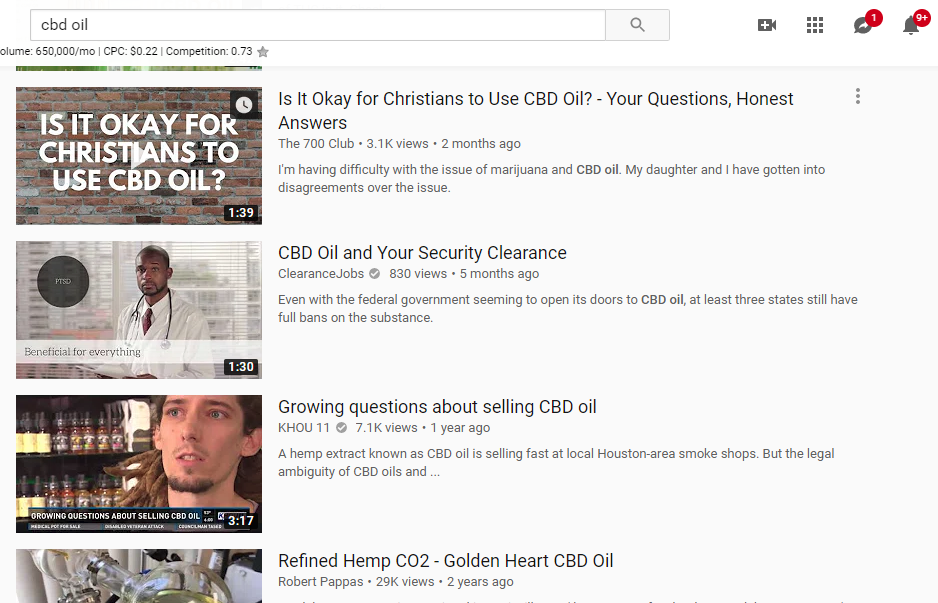
Stuff I never would have thought about, but would totally watch. Here’s quick hit list of a few other topics I found as a result of my CBD Oil query:
- Should I Take CBD Oil for My Anxiet? – BBC Stories
- Medical Marijuana and Parkinson’s – Ride with Larry
- Autism Son Tries CBD Oil – Autism Families
- What to Look for When Buying CBD Oil (Roy Krebs)- Biohackers Lab
- CBD Oil for Anxiety: Unexpected Effects and Benefits – Depression to Expression
- I Tried CBD Oil; It Didn’t Go Well – WheezyNews
- How Much CBD Oil Should I Take? – Rawls MD
- CBD Oil vs Copaiba Oil – Dr. Hill and Dr. O Discuss How CBD and Copaiba Work – doTerra Essential Oils
Initiating a broad topic query on YouTube will turn up a wider range of results because YouTube search results aren’t as focused on search intent as Google when it delivers results.
For marketers, that means you don’t have to wait for someone to search your weird topic in order to show up in search results. It also means you have options beyond pre-roll and mid-roll YouTube ads… though you could go that route.
(Just remember what I said about Gen X and paid ads – they’re not that into them.)
Instead, you could partner with one or two popular influencers who can create a long-form video that gets repurposed into smaller, five- or ten-minute spots that are topical.
Here’s a really good example…
The video below is actually a powerful example of the nuances of CBD use beyond just your typical “Benefits of CBD” content. It’s both entertaining and insightful and deals specifically with how CBD and THC affect sleep and brain recovery.
What?
Yeah. Sleep and brain recovery. I’m a total geek about this kinda stuff. I literally just watched a 90-minute documentary about how vitamins D and B12 impact cognition, memory and recovery. I just like that sort of thing.
But you can create these kinds of…virtual CBD rabbit holes on YouTube where vitality nerds, documentary geeks, would-be Jeopardy contestants and Dosing Dads can get sucked in.
Check out this CBD subtopic that showed up in my YouTube search results. It’s my man, Joe interviewing endurance athlete, Ben Greenfield.
Notice how Ben (thought leader in the body-hacking/vitality space) talks about the grogginess he feels when he wakes up in the morning after taking CBD (good to know when you’re one of the 76 percent of Dosing Dads who is employed full time).
He also talks about the differences in the types of sleep you get with CBD compared to THC. This is super-specific content. And for viewers, it means having access to insights you don’t typically get in a “Benefits of CBD” infographic. This is the stuff novice CBD users (and more than half of current CBD users are novices) may not have previously considered. And it’s important information to know.
If you remember, we said earlier most people who take CBD take it to address a specific issue. As a marketer, you can WIN with this kind of practical, high-value content.
Conclusion
To get the attention of Dosing Dads, CBD brands benefit from an omnichannel marketing strategy that includes traditional Instagram influencer marketing as well as video marketing. For Instagram posts, focus on creating content that you know appeals specifically to men over 40 and that provides them value beyond just being eye-catching. For your video marketing efforts, skip the animated explainer videos and pre-roll ads that only get shown to viewers in your area. Instead, create catalogs of super-useful content that provide unmatched value and insights to Dosing Dads. If you can build a sort of encyclopedia of CBD as short-form video, you can make yourself an authority and a trusted resource. So, focus on educating your buyers (and thus boosting both retention and loyalty), and in the process show them a variety of CBD products to meet their very specific needs.
Put the work in.







